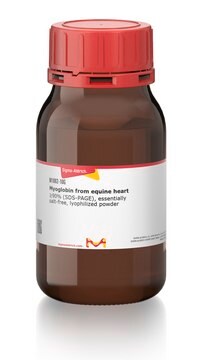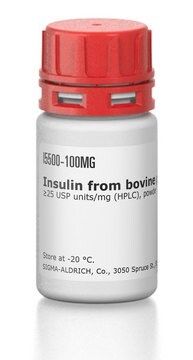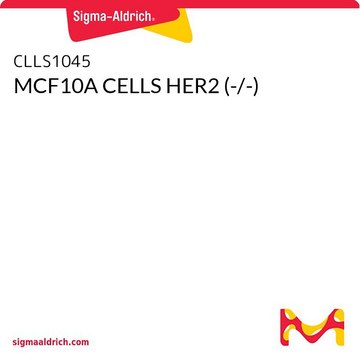CLL1039
MCF10A RFP-TUBA1B
human female maMilliporeary glands (Source Disease: Fibrocystic Disease)
Iniciar sesiónpara Ver la Fijación de precios por contrato y de la organización
About This Item
UNSPSC Code:
41106514
eCl@ss:
32190102
NACRES:
NA.81
Productos recomendados
product name
MCF10A RFP-TUBA1B,
biological source
human female mammary glands (Source Disese: Fibrocystic disease)
OMIM accession no.
storage temp.
−196°C
Gene Information
human ... TUBA1B(10376)
General description
K-α1 tubulin/ tubulin α 1b (TUBA1B) is a microtubule protein.It is a ~50 kDa protein in its poly glycosylated, post-translational form. TUBA1B is present in cells as one of the six different isotypes. This gene is located on human chromosome 12q13.12.
This product was derived from ATCC Cat. No. CRL-10317.
MCF10A RFP-TUBA1B are fibrocystic disease, epithelial cells, from a human female (aged 36 years), with a RFP-tagged modification.
MCF10A RFP-TUBA1B are fibrocystic disease, epithelial cells, from a human female (aged 36 years), with a RFP-tagged modification.
Application
MCF10A RFP-TUBA1B has been used in cell culture assays and western blot analysis.
MCF10A RFP-TUBA1B has been used to study the role of BRCA1 on the cell division axis.
This product is a human MCF10A cell line in which the genomic TUBA1B gene has been endogenously tagged with a Red Fluorescent Protein (RFP) gene using CompoZr® Zinc Finger Nuclease technology. Integration resulted in endogenous expression of the fusion protein in which RFP is attached to the N-terminus of tubulin. Fluorescence imaging shows that the tubulin can polymerize to form the characteristic pattern of microtubules. Addition of paclitaxel causes the expected bundling of microtubules. This stable cell line was expanded from a single clone. The target′s gene regulation and corresponding protein function are preserved in contrast to cell lines with overexpression via an exogenous promoter.
To learn more, please visit the Cellular Reporter Cell Line webpage
Biochem/physiol Actions
K-α1 tubulin/ tubulin α 1b (TUBA1B) participates in several cellular activities like GTP binding, GTPase activity, maintaining cellular structure in the form of microtubules and microtubule-based intracellular movement. It plays a crucial role in polymerization and depolymerization during cell replication and division. TUBA1B is overexpressed in hepatocellular carcinoma (HCC) tumor tissues and proliferating HCC cells.
Tubulin α 1b (TUBA1B) is a microtubule protein, which plays a vital role in dynamic process of polymerization and depolymerization during cell replication and division. TUBA1B is overexpressed in hepatocellular carcinoma (HCC) tumor tissues and proliferating HCC cells. This upregulated expression of the gene leads to poor prognosis and chemotherapy resistance in HCC.
Features and Benefits
RFP-tagged on chromosome 12q13.12.
MCF10A cells are adherent, with a doubling time of approx.20 hours.
MCF10A cells are adherent, with a doubling time of approx.20 hours.
Components
MCF10A RFP-TUBA1B cells
Quality
Tested for Mycoplasma, sterility, post-freeze viability, short terminal repeat (STR) analysis for cell line identification, PCR assay for cell line species confirmation.
Preparation Note
Media Renewal changes two to three times per week.
Rapidly thaw the vial by gentle agitation in a 37°C water bath (~2 minutes), keeping the vial cap out of the water. Decontaminate with 70% ethanol, add 9 mL culture media and centrifuge 125 x g (5-7 minutes). Resuspend in complete culture media and incubate at 37°C in a 5% CO2 atmosphere.
Subculture Ratio: approx. 1:3 to 1:4
The base medium for this cell line is Dulbecco′s Modified Eagle′s Medium/Ham′s Nutrient Mixture F-12, Cat. No. 51448C. To make the complete growth medium, add the following components to the base medium: horse serum, Cat. No. H1270, to a final concentration (v/v) of 5%; cholera toxin, Cat. No. C8052, to a final concentration of 1 ng/mL, human insulin, Cat. No. I9278, to a final concentration of 10 μg/mL, epidermal growth factor, Cat. No. E9644, to a final concentration of 10 ng/mL; and hydrocortisone, Cat. No. H6909, to a final concentration of 0.5 μg/mL.
The cell freezing medium is DMSO 1X (Cat. No. C6164).
Rapidly thaw the vial by gentle agitation in a 37°C water bath (~2 minutes), keeping the vial cap out of the water. Decontaminate with 70% ethanol, add 9 mL culture media and centrifuge 125 x g (5-7 minutes). Resuspend in complete culture media and incubate at 37°C in a 5% CO2 atmosphere.
Subculture Ratio: approx. 1:3 to 1:4
The base medium for this cell line is Dulbecco′s Modified Eagle′s Medium/Ham′s Nutrient Mixture F-12, Cat. No. 51448C. To make the complete growth medium, add the following components to the base medium: horse serum, Cat. No. H1270, to a final concentration (v/v) of 5%; cholera toxin, Cat. No. C8052, to a final concentration of 1 ng/mL, human insulin, Cat. No. I9278, to a final concentration of 10 μg/mL, epidermal growth factor, Cat. No. E9644, to a final concentration of 10 ng/mL; and hydrocortisone, Cat. No. H6909, to a final concentration of 0.5 μg/mL.
The cell freezing medium is DMSO 1X (Cat. No. C6164).
Legal Information
CompoZr is a registered trademark of Merck KGaA, Darmstadt, Germany
Disclaimer
RESEARCH USE ONLY. This product is regulated in France when intended to be used for scientific purposes, including for import and export activities (Article L 1211-1 paragraph 2 of the Public Health Code). The purchaser (i.e. enduser) is required to obtain an import authorization from the France Ministry of Research referred in the Article L1245-5-1 II. of Public Health Code. By ordering this product, you are confirming that you have obtained the proper import authorization.
Related product
Storage Class
10 - Combustible liquids
wgk_germany
WGK 3
flash_point_f
188.6 °F - closed cup
flash_point_c
87 °C - closed cup
Certificados de análisis (COA)
Busque Certificados de análisis (COA) introduciendo el número de lote del producto. Los números de lote se encuentran en la etiqueta del producto después de las palabras «Lot» o «Batch»
¿Ya tiene este producto?
Encuentre la documentación para los productos que ha comprado recientemente en la Biblioteca de documentos.
BRCA1 controls the cell division axis and governs ploidy and phenotype in human mammary cells
He Z, et al.
Oncotarget, 8(20), 32461-32461 (2017)
Zhengcheng He et al.
Oncotarget, 8(20), 32461-32475 (2017-04-22)
BRCA1 deficiency may perturb the differentiation hierarchy present in the normal mammary gland and is associated with the genesis of breast cancers that are genomically unstable and typically display a basal-like transcriptome. Oriented cell division is a mechanism known to
De novo production of K-α1 tubulin-specific antibodies: role in chronic lung allograft rejection.
Goers TA, et al.
Journal of Immunology, 180(7), 4487-4494 (2008)
Increased α-tubulin1b expression indicates poor prognosis and resistance to chemotherapy in hepatocellular carcinoma.
Lu C, et al.
Digestive Diseases and Sciences, 58(9), 2713-2720 (2013)
Up-regulation of TUBA1B promotes astrocyte proliferation after spinal cord injury in adult rats.
Liu Y, et al.
International Journal of Clinical and Experimental Pathology, 10(2), 1094-1103 (2017)
Nuestro equipo de científicos tiene experiencia en todas las áreas de investigación: Ciencias de la vida, Ciencia de los materiales, Síntesis química, Cromatografía, Analítica y muchas otras.
Póngase en contacto con el Servicio técnico





